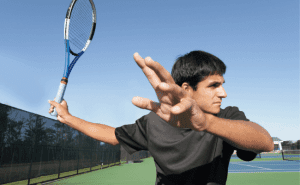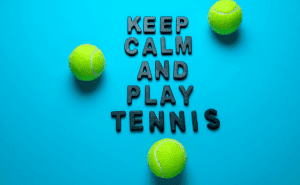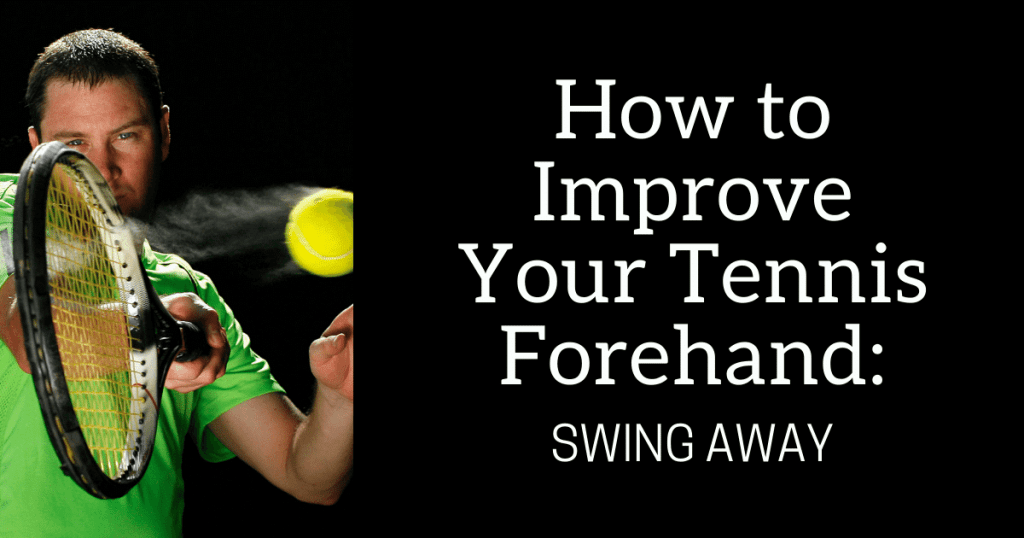To improve your tennis forehand there are several key points to understand. Keep in mind when you are hitting the ball, it is not just your hand or racket that are moving, it is your entire body.
As we go through this tutorial, think about each part of your body and what it is doing (or not doing).
Contents
Clear the Net Mentality
Before we get into the mechanics of the perfect forehand swing, there is a mindset that needs to be adopted.
Do not think about winning as your primary goal. I know it sounds crazy, but this is not the only reason you are playing tennis!
KEY TAKEAWAY – Think only about one goal before you hit any groundstroke. That goal is to clear the net, period, full stop. So many forehands end up in the net and they really don’t have to. When you focus on clearing the net every single time, you are virtually guaranteed to be a better tennis player!
Use a Semi Western Forehand Grip
We’ve covered the nuances of the many ways to hold on to/grip a tennis racquet here if you need more of a primer. Getting into the physical steps of hitting a tennis forehand begins with the hands.
The semi western grip is often misused or just done completely wrong (even by good players)! If you are going to have an awesome forehand groundstroke it starts with the way you are holding the racquet.
The semi western grip is not a beginner grip. If you’re more comfortable with an eastern grip, that works too. If hitting a forehand slice, the continental grip or eastern forehand grip would be more appropriate.
Do not confuse the semi western grip with the spaghetti western grip, I have seen this before and it is not pretty (cue music).
Body Position to Hit a Forehand
Position yourself to receive the ball as usual (ready position facing the net).
Go back to the basics with regard to tennis technique. Be light on your feet. It is much better to be moving, almost sort of dancing, shifting your weight from foot to foot with both your hitting and non hitting hands on your tennis racquet.
This slightly moving stance will much better prepare you to have a good forehand swing when the ball comes. You don’t want to be caught flat footed as you’re almost sure to be late to the shot.
Preparing to Hit a Forehand

When the ball is on the way toward you on your forehand side, turn to the side and get the racquet back.
The backswing is often overlooked, but it is a primary component of the entirety of the forehand groundstroke.
This is a timing issue that you’ll get used to over time, but having the racquet back is important. Put your non-dominant hand out in front of your body to help you keep your balance.
Use Your Legs to Give Your Forehand a Boost
Finesse is used in tennis, but often you want to hit your forehands with some oomph. Getting power into a forehand groundstroke does not happen by using all your strength in your arm to smack the ball as hard as you can into oblivion!
Relax your arm and focus on making contact with the ball. Step into the shot. Use your legs as they have very large muscles in there.
Turn your body and let the uncorking motion create momentum. Rotate your hips and keep your arm loose. Be sure to watch the ball hit your strings. (You’d be amazed at how many people close their eyes or just aren’t looking at the ball hit the racquet when hitting groundstrokes.)
Hitting a Topspin Forehand
Adding topspin will accelerate the ball and can make it more difficult for your opponent to return your shot. A topspin shot also makes the ball drop when it gets toward the end of its trajectory likely keeping it inside the baseline, while maintaining its power and speed.
Topspin is an important ingredient in the perfect tennis forehand (if that exists) and mastering it is a critical component.
During your backswing, position the racquet down low so that when you strike the ball, the racquet head moves in a low to high motion.
On impact with the ball, the racquet face will not be open – it’ll be slightly closed.
The strings rubbing the back of the ball while the racquet is on an upward trajectory is what will cause the ball to have topspin. If you prepared your shot correctly the momentum behind your swing and the movement of the racquet will result in a powerful fast-moving ball with plenty of spin.
The Path of the Swing
The path of your tennis forehand swing should be a straight line from the back of the swing through after you have hit the ball. By keeping a straight swing path, you can control the ball much better, and controlling the ball controls the point!

Focus on keeping the swing path as straight as possible before and after contact.
This will take practice but is well worth the effort. This is one of the key ingredients in having an amazing tennis forehand.
Forehand Extension and Follow Through
After the ball is struck you want to let your swing finish and the momentum to naturally stop. The straight-line path will change a little bit at the very end.
When the ball is moving toward the other side of the court let your racquet arm follow the ball a little.
Aiming after the fact (crazy right?)
Setting up your body position is important, but the mechanics of your forehand shot before, during and after the swing are all important. Think of it sort of like aiming where you want it to go after the fact.
This seems odd but it happens extremely fast and if you plan on following the ball where you want it to go after you hit it, it causes you to aim the ball very accurately before you hit it!
KEY TAKEAWAY – The direction the ball goes is determined by the setup of your feet and torso, not your arm. Yes, the pros can muscle balls to every part of the court with an open stance and make magic happen worthy of highlight reels. Most weekend warriors aren’t as talented (duh!). Position your body/feet properly so you can hit shots all over the court with precision.
Final Forehand Follow Through Step
Final follow through is easy to get wrong. Most right-handed players tend to let their left arm drop after the shot and the right arm is the only one doing any follow through.
When it is done this way, your shoulders will block one another, and your hitting arm will be confined. You won’t be able to easily swing at the ball.

Instead, focus on rotating your body and shoulder on the follow through and catch the racket with your non-racket hand.
When you do it this way your shoulders and arms are positioned to respond to the next shot (ready position), and the momentum from your forward swing can resolve in your catching arm and shoulder.
This resolution of momentum will take strain off your racket arm and take much less energy over the course of a match.
Keep Your Mental State in Check
Tennis is a physical sport. It’s also incredibly mental. There is no way to approach getting a better forehand groundstroke without explaining the importance of your mental state while playing.
A key aspect to getting a killer forehand is your mental state and focus. Do not let every point you lose effect your attitude or emotions while you are on the court.
Keeping Your Cool on the Tennis Court

Keeping a poker face and showing up to a match with a clear head will guarantee you are going to win (maybe not, but you will lose with a bad attitude and head full of thoughts, guaranteed!)
In fact, it has been said by Olympic gold medalist Gigi Fernandez that tennis is 84.2% mental and 16.8% physical! Some of the most important parts of your mental state for tennis are to:
- Just play your best – You may not win every game, but if you are putting in your best effort that is all you can do. The goal should not be to beat your opponent, but to play as well as you can each time you step on court.
- Avoid any distractions – There can be distractions on court like people watching or noise or whatever. There are also distractions that are internal. If you’re anything like me, there are many thoughts always racing around in your head. Try your best to not latch onto them and let your mind focus on the game. Allow your tennis time to be a release from the daily grind of life.
- Let mistakes go instantly – When you know you made a mistake, instead of dwelling on it just let it go instantly. Keep your mind on the present. Forget about your previous shot. This definitely takes practice, but if you’re focusing on what you just did, you can’t focus on what you’re about to do – the next point.
- Clear your mind or meditate – Before a match do some breathing exercises and let go of any junk that is kicking around in your head. When you hit the court, your head should be ready for play.
Do not underestimate how crucial the proper state of mind is to improving your tennis forehand technique. If you are in a bad mood or mentally distressed, you will almost always have a bad time on court!
Time to Show off Your Improved Tennis Forehand
Tennis is a sport that takes time to learn and master.
If you love it like I do, the time spent honing your groundstrokes will be time well spent. You will likely benefit from doing lots of drills on your tennis ball machine.
Take some of these suggestions out for a test drive and I’m certain you’ll see improvement!

